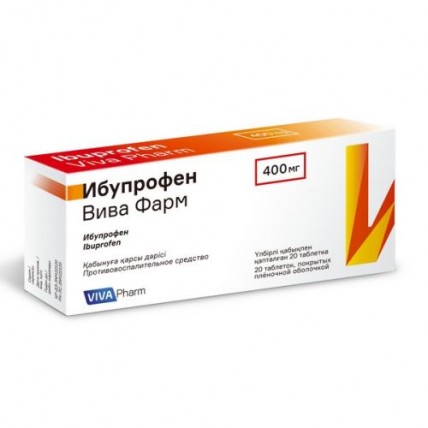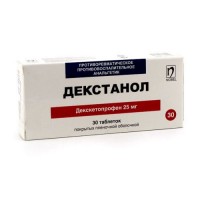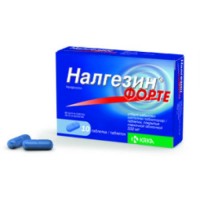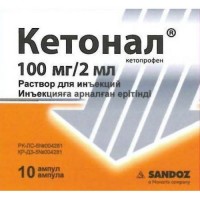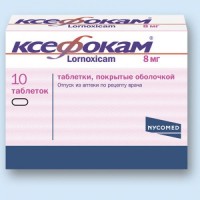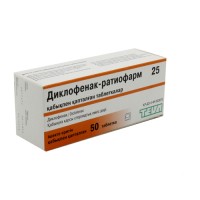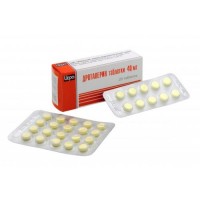Ibuprofen Viva Pharm 400 mg, 20 tablets
- $6.00
The instruction for medical use of medicine VIVA FARM Ibuprofen the Trade name VIVA FARM Ibuprofen the International unlicensed name Ibuprofen Dosage Form of the Tablet, film coated, 200 mg and 400 mg Structure One tablet contains active agent: ibuprofen of 200 mg or 400 mg, excipients: lactoses monohydrate, starch corn, cellulose microcrystalline (101 and 102), sodium of a kroskarmelloz, K30 povidone, magnesium stearate, aerosil, structure of a cover: Opadry® II 85F24336 PINK (polyvinyl alcohol, titan dioxide (E171), polyethyleneglycol/macrogoal, talc, ponso 4R (E124), FD&C yellow No. 6 (E110)). The description of the Tablet of round shape, with a biconvex surface, film coated pink color. Pharmacotherapeutic Musculoskeletal system group. Anti-inflammatory and antirheumatic drugs. Anti-inflammatory and antirheumatic drugs, nonsteroid. Propionic acid derivatives. Ibuprofen. ATX M01AE01 code the Pharmacological Pharmacokinetics Later properties of intake, an ibuprofen is quickly absorbed and distributed in an organism. Absorption of an ibuprofen – high, communication with proteins of blood plasma - 90%. Slowly gets into a cavity of joints, is late in synovial fabric, creating in it high concentrations, than in plasma. After absorption about 60% pharmacological of an inactive R-form are slowly transformed to an active S-form. The maximum concentration in blood plasma are reached in 45 minutes after reception on a hungry stomach. At administration of drug with food the maximum concentration in plasma are reached in 1-2 hours. Is exposed to metabolism in a liver. Drug is quickly and completely removed from an organism by kidneys (in an invariable look no more than 1%) and, to a lesser extent, with bile. Elimination half-life makes about 2 hours. A pharmacodynamics the Mechanism of action of an ibuprofen derivative of propionic acid from group of non-steroidal anti-inflammatory drugs (NPVP), is caused by inhibition of synthesis of prostaglandins – mediators of pain, inflammation and hyper thermal reaction. Not selectively blocks cyclooxygenase 1 (TsOG-1) and cyclooxygenase 2 (TsOG-2) owing to what slows down synthesis of prostaglandins. Has analgeziruyushchy, febrifugal and anti-inflammatory effect. Besides, the ibuprofen reversibly inhibits aggregation of thrombocytes. Indications Pain relief at the following states: - head and a toothache - migraine - painful periods - neuralgia - dorsodynias - muscular and rheumatic pains - a feverish state in flu and catarrhal diseases. A route of administration and doses For intake. Only for short-term use. Attentively read the instruction before administration of drug. The adult drug is appointed on 1 tablet (200 mg) up to 3 times a day. For achievement of faster therapeutic effect the dose can be increased up to 400 mg (2 tablets 200 mg or 1 tablet of 400 mg) up to 3 times a day. Tablets should be washed down with water. The interval between reception of tablets has to make not less than 4 hours. Maximum daily dose: 1200 mg (6 tablets 200 mg or 3 tablets of 400 mg). If at administration of drug within 2-3 days the symptoms remain or amplify, it is necessary to stop treatment and to see a doctor. In need of administration of drug more than 10 days, it is necessary to see a doctor. For reduction of risk of emergence of side effects it is recommended to take the drug the greatest possible short course and in the minimal effective dose necessary for elimination of symptoms. Side effects Side effects mainly are dose-dependent. Following side reactions were noted at short-term reception of an ibuprofen in the doses which are not exceeding 1200 mg/days. Results of clinical trials assume presence of possible interrelation between reception of an ibuprofen in doses ≥ 2400 mg a day and the small increased risk of development of the arterial trombotichesky phenomena (for example, a myocardial infarction and a stroke). At treatment of chronicities and at prolonged use the emergence of other side reactions is possible. Assessment of frequency of emergence of side reactions is made on the basis of the following criteria: Very often (≥ 1/10), it is frequent (≥ 1/100, & lt, 1/10), Infrequently (≥ 1/1000, & lt, 1/100), is rare (from ≥ 1/10,000, & lt, 1/1000), Is very rare (& lt, 1/10,000), It is unknown (frequency cannot be determined by the available data). Infrequently - reactions of hypersensitivity: nonspecific allergic reactions and anaphylactic reactions, reactions from airways (bronchial asthma, including its aggravation, a bronchospasm, an asthma, dispnoe), skin reactions (itching, urticaria, a purpura, a Quincke's edema), various types of skin rash. - abdominal pain, nausea, dyspepsia (including heartburn, abdominal distension). - headache. Seldom - diarrhea, the increased gas generation, a constipation and vomiting. Very seldom - hemopoiesis disturbances: anemia (decrease in level of hemoglobin), leukopenia, thrombocytopenia, pancytopenia, agranulocytosis. The first signs are fever, a sore throat, formation of ulcers in oral cavities, grippopodobny symptoms, heavy breakdown, causeless appearance of bleedings and hematomas. - heavy reactions of hypersensitivity, including edema of face, language and a throat, an asthma, tachycardia, hypotension (anaphylaxis, a Quincke's edema or a heavy acute anaphylaxis). - stomach ulcer (round ulcer) and a duodenum, perforation or gastrointestinal bleeding, a melena, a hematemesis, in certain cases from the death, is more often at patients of advanced age. - stomacace, gastritis. - an acute renal failure, papillonekroz, especially at prolonged use, in combination with increase in level of urea in blood serum and appearance of hypostases. - abnormal liver functions. - the complicated skin diseases: exfoliative and bullous dermatosis, including toxic epidermal necrolysis (Lyell's disease), Stephens-Johnson's syndrome, multiformny erythema. - at patients with autoimmune disorders (system lupus erythematosus, the mixed disease of connective tissue) during treatment by an ibuprofen observed isolated cases of emergence of symptoms of aseptic meningitis, in particular, stiff neck, a headache, nausea, vomiting, fever or disturbance of orientation. It is unknown - reactions from airways (bronchial asthma, including its aggravation, a bronchospasm, an asthma, dispnoe). - heart failure and hypostases. - hypertensia. - exacerbation of nonspecific ulcer colitis and Crohn's disease. - renal failure. Contraindications - hypersensitivity to an ibuprofen or to any of drug components - the reactions of hypersensitivity in the anamnesis (in particular, bronchial asthma, rhinitis, a Quincke's edema or a small tortoiseshell) provoked by intake of acetylsalicylic acid or other non-steroidal anti-inflammatory drugs - a peptic ulcer / helcomenia in a stage of aggravation or in the anamnesis (two and more confirmed an episode) - bleeding from digestive tract or perforation, NPVP provoked by use, and in the anamnesis - the profound dehydration (as a result of vomiting, diarrhea or insufficient consumption of liquid) - hemophilia and other disturbances of blood clotting (including hypocoagulations), hemorrhagic diathesis - a heavy liver failure - a heavy renal failure - heavy heart failure (class IV on NYHA - classification of the New York Association of cardiologists) - pregnancy (III trimester) and the lactation period - children's and teenage age up to 18 years - persons with hereditary intolerance of fructose, deficiency of Lapp-lactases enzyme, glucose galactose malabsorption. Medicinal interactions It is necessary to avoid simultaneous use of an ibuprofen (and other NPVP) with the following drugs: Acetylsalicylic acid: simultaneous use of an ibuprofen and acetylsalicylic acid in connection with possible increase in development of the undesirable phenomena is not recommended. The ibuprofen at simultaneous use with low doses of acetylsalicylic acid can inhibit aggregation of thrombocytes competitively. Though the admissibility of extrapolation of these data on clinical practice remains uncertain, it is impossible to exclude potential impact of regular long reception of an ibuprofen on decrease in cardiotyre-tread action of low doses of acetylsalicylic acid. Influence of incidental use of an ibuprofen on cardiotyre-tread properties of acetylsalicylic acid is represented improbable. Other NPVP, in particular, selection inhibitors of cyclooxygenase-2: it is necessary to avoid simultaneous use of two and more drugs from the NPVP group because of possible increase in risk of emergence of side effects. With care to appoint along with the following drugs: Glucocorticosteroids: because of possible increase in risk of developing of ulcers or gastrointestinal bleeding. Hypotensive drugs and diuretics: NPVP can reduce efficiency of drugs of these groups. Simultaneous use with diuretics can lead to increase in nephrotoxicity of NPVP. Anticoagulants: NPVP can enhance effect of anticoagulants, in particular, of warfarin. Antiagreganta and selective serotonin reuptake inhibitors (SSRI): the increased risk of developing of gastrointestinal bleeding. Cardiac glycosides: co-administration of NPVP and cardiac glycosides can lead to aggravation of heart failure, reduction in the rate of glomerular filtration and increase in concentration of cardiac glycosides in blood plasma. Lithium drugs: there are increases in concentration of lithium given about probability in blood plasma against the background of use of NPVP. Methotrexate: there are increases in concentration of a methotrexate given about probability in blood plasma against the background of use of NPVP. Cyclosporine: increase in risk of nephrotoxicity at co-administration of NPVP and cyclosporine. Mifepristone: reception of NPVP should be begun not earlier than in 8-12 days after intake of mifepristone as NPVP can reduce efficiency of mifepristone. Takrolimus: at co-administration of NPVP and takrolimus the increase in risk of nephrotoxicity is possible. Zidovudine: simultaneous use of NPVP and zidovudine can lead to increase in hematologic toxicity. Are available given about the increased risk of developing of a hemarthrosis and hematomas at the HIV-positive patients with hemophilia receiving joint treatment by a zidovudine and an ibuprofen. Antibiotics of a hinolonovy row: at the patients receiving joint treatment by NPVP and antibiotics of a hinolonovy row the increase in risk of developing of spasms is possible. Special instructions in the presence of the states specified in this section before use of drug it is necessary to see a doctor. Undesirable effects can be minimized if to take the drug during a short period, in the minimal effective dose necessary for elimination of symptoms. At people of advanced age the increased frequency of side reactions against the background of use of NPVP, especially gastrointestinal bleedings and perforation, in certain cases from the death is observed. Influence on respiratory organs: at patients with bronchial asthma or an allergic disease in an aggravation stage and also at patients with the anamnesis of bronchial asthma / an allergic disease drug can provoke a bronchospasm. When smoking, before use of drug it is necessary to consult with the expert. Sharing with other NPVP: it is necessary to avoid simultaneous use of an ibuprofen with other NPVP, in particular, selection inhibitors of cyclooxygenase-2. System lupus erythematosus and the mixed disease of connective tissue: use of drug for patients with a system lupus erythematosus or the mixed disease of connective tissue is connected with the increased risk of developing aseptic meningitis. Influence on kidneys: drug can cause deterioration in function of kidneys with development of a renal failure. Influence on a liver: drug can cause an abnormal liver function. Influence on a cardiovascular system and cerebral circulation: it is recommended to use with care drug at patients with arterial hypertension and/or heart failure (before use it is necessary to consult with the doctor) because of the available messages about a liquid delay, increase in arterial blood pressure and appearance of hypostases against the background of use of NPVP. To patients with uncontrollable arterial hypertension, stagnant heart failure of the II-III class on NYHA established by coronary heart disease, diseases of peripheral arteries and/or cerebrovascular diseases it is necessary to appoint an ibuprofen only after careful assessment of a ratio advantage risk, at the same time it is necessary to avoid use of high doses of an ibuprofen (≥ 2400 mg/days). Influence on digestive tract: it is necessary to use with care drug at the patients having in the anamnesis of a disease of digestive tract (nonspecific ulcer colitis, Crohn's disease) as when using drugs of this group the exacerbation of these diseases is possible. There are messages about cases of developing of gastrointestinal bleeding, ulcers and perforation at any moment of use of any drugs from the NPVP group, at existence or lack of the warning symptoms or the previous anamnesis of similar complications. The increased risk of gastrointestinal bleeding or ulcer/perforation is connected with use of high doses of NPVP, existence in the anamnesis of the patient of a peptic ulcer, especially, complicated bleeding or perforation and also using drug at people of advanced age. At the listed categories of patients the treatment should be begun with the smallest effective dose of drug. Patients with manifestation of toxicity from digestive tract in the anamnesis, especially sick advanced age, have to report about any unusual symptoms from digestive tract (in particular, in case of gastrointestinal bleeding), especially in an initiation of treatment. When developing gastrointestinal bleeding or ulcer at the patients receiving treatment by an ibuprofen, administration of drug should be stopped. There are limited data that the medicines inhibiting synthesis of cyclooxygenases/prostaglandins can cause disturbance of reproductive function in women owing to influence on process of an ovulation. This effect is reversible at the termination of administration of drug. Influence on integuments: there are separate messages about very exceptional cases of development of the serious skin reactions connected with reception of NPVP, in certain cases up to development of lethal consequences including exfoliative dermatitis, Stephens-Johnson's syndrome, and a toxic epidermal necrolysis. The highest risk of emergence of these reactions was noted at the beginning of therapy (in most cases in the first month of treatment). It is necessary to stop reception of an ibuprofen at appearance of an enanthesis, damages on mucous membranes or other signs of hypersensitivity. Pregnancy and the period of a lactation Inhibition of synthesis of prostaglandin can is mediated to influence a pregnancy course, development of an embryo and a fruit. Some data confirm the increased risk of a misbirth, heart diseases and a gastroshizis when using inhibitors of synthesis of prostaglandins in the early stages of pregnancy. The absolute risk of emergence of anomalies of a cardiovascular system increased from less than 1% approximately to 1.5%. This risk increases with increase in a dosage and duration of therapy. In this regard, it is necessary to avoid use of drug in the I-II trimesters of pregnancy, in need of administration of drug it is necessary to consult with the doctor. At reception of an ibuprofen by women, planning pregnancy, or in the I-II trimesters of pregnancy the dosage and duration of treatment have to be minimum. Use of inhibitors of prostaglandin in the III trimester of pregnancy contributes to the development in a fruit and in mother: - kardiopulmonarny insufficiency with premature closing of an arterial channel and development of pulmonary hypertensia, - a renal failure which can lead to complete cessation of functioning of kidneys with development of an oligoamnios (dehydration), - increases in a bleeding time, to anti-aggregation effect even at very low doses, - under
a vleniya of sokratitelny activity of a uterus and to overdue or long childbirth. In this regard, the ibuprofen is contraindicated in the third trimester of pregnancy. Features of influence of medicine on ability to run vehicles or potentially dangerous mechanisms Considering possible side effects, it is necessary to be careful when driving or potentially dangerous mechanisms. The overdose At adults elimination half-life of drug at overdose makes 1.5 — 3 hours. Symptoms: at most of the patients who used clinically significant doses of NPVP, symptoms of overdose are limited to nausea, vomiting, pains in epigastriums or, more rare, diarrhea. Emergence of such symptoms as sonitus, a headache and gastrointestinal bleeding is possible. In more hard cases manifestations of toxicity from the central nervous system are observed, in particular, drowsiness, occasionally – excitement and also a disorientation or a coma, in rare instances arise spasms. In cases of a serious poisoning the metabolic acidosis and increase in a prothrombin time can develop that is probably connected with interaction of drug and the circulating blood-coagulation factors. There can be an acute renal failure and injury of a liver. At patients with bronchial asthma the exacerbation of this disease is possible. Treatment: symptomatic and supporting, with obligatory ensuring free passability of airways, monitoring of warm activity and key indicators of activity before normalization of a condition of the patient. Oral administration of activated carbon within one hour after reception of potentially toxic dose of drug is recommended. Frequent or long spasms should be stopped intravenous administration of diazepam or lorazepam. In bronchial asthma the use of bronchodilators is recommended. The form of release and packing On 7 tablets (for a dosage of 200 mg) or 10 tablets (for a dosage of 400 mg) place in blister strip packaging from a film of polyvinylchloride and aluminum foil. On 2 blister strip packagings together with the instruction for medical use in the Kazakh and Russian languages put in a pack from cardboard. To Store storage conditions in the dry place, at a temperature not above 25 °C. To store out of children's reach! Period of storage 3 years. Not to apply after an expiration date. Prescription status Without prescription. VIVA Pharm LLP producer, Republic of Kazakhstan 2nd Ostroumova St., 33, Almaty the Owner of the registration certificate of VIVA Pharm LLP, Republic of Kazakhstan 2nd Ostroumova St., 33, Almaty of the Name, the address and a contact information (phone, the fax, e-mail) of the organization in the territory of the Republic of Kazakhstan, the accepting claim (offer) on quality of medicines and responsible for post-registration observation of safety of medicine: VIVA Pharm LLP, Republic of Kazakhstan 2nd Ostroumova St., 33, Almaty, 050030 ph.: +7 (727) 383 74 63, fax: +7 (727) 383 74 56 e-mail:
To Develop pv@vivapharm.kz
a vleniya of sokratitelny activity of a uterus and to overdue or long childbirth. In this regard, the ibuprofen is contraindicated in the third trimester of pregnancy. Features of influence of medicine on ability to run vehicles or potentially dangerous mechanisms Considering possible side effects, it is necessary to be careful when driving or potentially dangerous mechanisms. The overdose At adults elimination half-life of drug at overdose makes 1.5 — 3 hours. Symptoms: at most of the patients who used clinically significant doses of NPVP, symptoms of overdose are limited to nausea, vomiting, pains in epigastriums or, more rare, diarrhea. Emergence of such symptoms as sonitus, a headache and gastrointestinal bleeding is possible. In more hard cases manifestations of toxicity from the central nervous system are observed, in particular, drowsiness, occasionally – excitement and also a disorientation or a coma, in rare instances arise spasms. In cases of a serious poisoning the metabolic acidosis and increase in a prothrombin time can develop that is probably connected with interaction of drug and the circulating blood-coagulation factors. There can be an acute renal failure and injury of a liver. At patients with bronchial asthma the exacerbation of this disease is possible. Treatment: symptomatic and supporting, with obligatory ensuring free passability of airways, monitoring of warm activity and key indicators of activity before normalization of a condition of the patient. Oral administration of activated carbon within one hour after reception of potentially toxic dose of drug is recommended. Frequent or long spasms should be stopped intravenous administration of diazepam or lorazepam. In bronchial asthma the use of bronchodilators is recommended. The form of release and packing On 7 tablets (for a dosage of 200 mg) or 10 tablets (for a dosage of 400 mg) place in blister strip packaging from a film of polyvinylchloride and aluminum foil. On 2 blister strip packagings together with the instruction for medical use in the Kazakh and Russian languages put in a pack from cardboard. To Store storage conditions in the dry place, at a temperature not above 25 °C. To store out of children's reach! Period of storage 3 years. Not to apply after an expiration date. Prescription status Without prescription. VIVA Pharm LLP producer, Republic of Kazakhstan 2nd Ostroumova St., 33, Almaty the Owner of the registration certificate of VIVA Pharm LLP, Republic of Kazakhstan 2nd Ostroumova St., 33, Almaty of the Name, the address and a contact information (phone, the fax, e-mail) of the organization in the territory of the Republic of Kazakhstan, the accepting claim (offer) on quality of medicines and responsible for post-registration observation of safety of medicine: VIVA Pharm LLP, Republic of Kazakhstan 2nd Ostroumova St., 33, Almaty, 050030 ph.: +7 (727) 383 74 63, fax: +7 (727) 383 74 56 e-mail:
To Develop pv@vivapharm.kz
